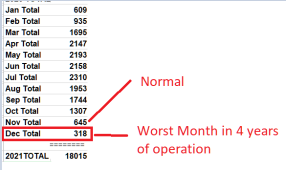PNW_Solar_Guy
New Member
- Joined
- Mar 31, 2022
- Messages
- 25
Hi All,
I've been reading through a number of threads on the forum, it's great to see so much support on here.
I essentially have no experience with solar but I would love to learn from some of you much more experienced folk out there on the system we are working on so far.
We have 65 acres in Oregon and were told by the electric company that it would cost $25k to tie us in to the grid. We were already thinking solar down the line, but that grid tie in price tag pushed us over the edge.
We plan to build a farm garage/outbuilding on that corner of the property (where there is no power), and then in a few years build a home next to it. We want this system to be expandable so we have plenty of power for both buildings by that point. But we're starting with just enough power for the garage/outbuilding for now.
I've attached our electrical design file to this thread, as well as a list (below) of the main details. If I'm omitting something please do reply and ask for it. I'm prepared to receive constructive criticism on this, as it's our first go at putting together plans for an off-grid solar system.
System details
Solar Array
Mount type: ground mount (adjustable between 18-65 degrees for our region)
Total panels / arrays (current): 70 / 5
Total kW (current): 32.2kW
Total panels / arrays (eventual): 120 / 9
Total kW (eventual): 55.2kW
Panel info: BlueSun 460w bifacial (model BSM460M-72HBD)
Panel configuration: 7S2P
Notes: Arrays are located exactly 300ft from the solar shed, where the inverters and batteries will be stored
Inverters
Desired AC output: 120/240v split phase power
Inverter model: MPP Solar LVX6048
Total inverters (current): 5 (in parallel)
Total inverters (eventual): 9 (in parallel)
**(Is this overkill? Should I just purchase cheaper charge controllers, and then one or two split phase inverters for the 120/240v service I need, instead of 5-9 LVX6048's?
Batteries
Battery model: Pytes LiFePO4 48V 5.1kWh battery
Total batteries (current): 5 (in parallel)
Total batteries (eventual): 20 (in parallel)
Loads
The buried line from the load panels in the solar shed to the garage (and eventually the house too) is exactly 170ft.
For our garage/outbuilding, we expect the loads to be minimal, between 10-20kw/day depending on the work that is being done there. In a few years when the house is built next to it, we expect the daily load to be between 60-80kw/day. We will have our main load suckers (heater, range/oven, hot water heater, dryer) all running off of our LP tank buried outside
I hope this is enough information to paint the broad strokes. I'm hoping to borrow some of your wisdom on this one as I am certain there are element's that I'm overlooking and that I need to dive more deeply into.
Cheers!
I've been reading through a number of threads on the forum, it's great to see so much support on here.
I essentially have no experience with solar but I would love to learn from some of you much more experienced folk out there on the system we are working on so far.
We have 65 acres in Oregon and were told by the electric company that it would cost $25k to tie us in to the grid. We were already thinking solar down the line, but that grid tie in price tag pushed us over the edge.
We plan to build a farm garage/outbuilding on that corner of the property (where there is no power), and then in a few years build a home next to it. We want this system to be expandable so we have plenty of power for both buildings by that point. But we're starting with just enough power for the garage/outbuilding for now.
I've attached our electrical design file to this thread, as well as a list (below) of the main details. If I'm omitting something please do reply and ask for it. I'm prepared to receive constructive criticism on this, as it's our first go at putting together plans for an off-grid solar system.
System details
Solar Array
Mount type: ground mount (adjustable between 18-65 degrees for our region)
Total panels / arrays (current): 70 / 5
Total kW (current): 32.2kW
Total panels / arrays (eventual): 120 / 9
Total kW (eventual): 55.2kW
Panel info: BlueSun 460w bifacial (model BSM460M-72HBD)
Panel configuration: 7S2P
Notes: Arrays are located exactly 300ft from the solar shed, where the inverters and batteries will be stored
Inverters
Desired AC output: 120/240v split phase power
Inverter model: MPP Solar LVX6048
Total inverters (current): 5 (in parallel)
Total inverters (eventual): 9 (in parallel)
**(Is this overkill? Should I just purchase cheaper charge controllers, and then one or two split phase inverters for the 120/240v service I need, instead of 5-9 LVX6048's?
Batteries
Battery model: Pytes LiFePO4 48V 5.1kWh battery
Total batteries (current): 5 (in parallel)
Total batteries (eventual): 20 (in parallel)
Loads
The buried line from the load panels in the solar shed to the garage (and eventually the house too) is exactly 170ft.
For our garage/outbuilding, we expect the loads to be minimal, between 10-20kw/day depending on the work that is being done there. In a few years when the house is built next to it, we expect the daily load to be between 60-80kw/day. We will have our main load suckers (heater, range/oven, hot water heater, dryer) all running off of our LP tank buried outside
I hope this is enough information to paint the broad strokes. I'm hoping to borrow some of your wisdom on this one as I am certain there are element's that I'm overlooking and that I need to dive more deeply into.
Cheers!






